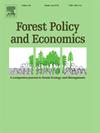Long-term forestation-deforestation dynamics in a socioeconomic perspective: The case of Italy, 1936–2018
IF 3.8
2区 农林科学
Q1 ECONOMICS
引用次数: 0
Abstract
To explore long-term socio-ecological relationships at the local scale, this study investigates the evolution of forest cover (1936–2018) vis à vis population, settlements, and economic activities in Italy using geo-spatial information sources that combine environmental and socioeconomic indicators. Long-term forestation (or deforestation) dynamics were assessed in more than 8000 municipalities through a comprehensive analysis of the background socioeconomic context. A multivariate framework integrating descriptive statistics and maps, exploratory pairwise correlations, and a confirmative canonical correlation analysis, has discriminated five distinctive paths in forest cover change over time. Urbanization-driven deforestation in accessible and economically dynamic flat-hilly districts, and forestation after land abandonment in remote rural areas, have been the most frequent processes of landscape transformation in Italy. The empirical findings of this study reveal the complex interactions between forests and local communities, thus supporting the core assumption of the well-known Forest Transition Theory, a key research topic in forest assessment and policy. A peculiar contribution of this research lies in highlighting local specificities in forest dynamics, which are shown to depend strictly on the economic and demographic characteristics of local communities, as well as on the degree of land protection. Triggering a path of sustainable development in rural areas requires policies that combine factors potentially beneficial for the environment, such as the expansion of forests, in order to create a more balanced set of socio-ecological conditions. This will help reducing depopulation and fostering local economies through low-impact socio-demographic processes that are compatible with the environmental quality typical of ‘forest dominated’ landscapes.

社会经济视角下的长期造林-毁林动态:意大利1936-2018年的案例
为了探索当地尺度上的长期社会生态关系,本研究利用结合环境和社会经济指标的地理空间信息源,调查了意大利森林覆盖(1936-2018)相对于人口、定居点和经济活动的演变。通过对背景社会经济背景的综合分析,对8000多个城市的长期造林(或毁林)动态进行了评估。一个多变量框架整合了描述性统计和地图、探索性两两相关和确证性典型相关分析,区分了森林覆盖随时间变化的五种不同路径。城市化驱动的可达和经济活跃的平坦丘陵地区的森林砍伐,以及偏远农村地区土地废弃后的造林,是意大利最常见的景观转变过程。本研究的实证结果揭示了森林与当地社区之间复杂的相互作用,从而支持了著名的森林转型理论的核心假设,这是森林评估和政策的关键研究课题。这项研究的一个特别贡献在于突出了森林动态的地方特点,这些特点被证明严格取决于当地社区的经济和人口特征以及土地保护的程度。要在农村地区走上可持续发展的道路,就必须制定政策,把可能对环境有益的因素结合起来,例如扩大森林,以便创造一套更加平衡的社会生态条件。这将有助于减少人口减少,并通过与典型的“森林主导”景观的环境质量相适应的低影响社会人口进程促进当地经济。
本文章由计算机程序翻译,如有差异,请以英文原文为准。
求助全文
约1分钟内获得全文
求助全文
来源期刊

Forest Policy and Economics
农林科学-林学
CiteScore
9.00
自引率
7.50%
发文量
148
审稿时长
21.9 weeks
期刊介绍:
Forest Policy and Economics is a leading scientific journal that publishes peer-reviewed policy and economics research relating to forests, forested landscapes, forest-related industries, and other forest-relevant land uses. It also welcomes contributions from other social sciences and humanities perspectives that make clear theoretical, conceptual and methodological contributions to the existing state-of-the-art literature on forests and related land use systems. These disciplines include, but are not limited to, sociology, anthropology, human geography, history, jurisprudence, planning, development studies, and psychology research on forests. Forest Policy and Economics is global in scope and publishes multiple article types of high scientific standard. Acceptance for publication is subject to a double-blind peer-review process.
 求助内容:
求助内容: 应助结果提醒方式:
应助结果提醒方式:


